Here is my one day with my family going up into the mountain to go skiing/snowboarding. For storytelling, I wanted to show the journey from the drive up and down to the skiing to watching the view in the lodge.
Day in 30 Sec (58 sec…..) – Jackson Lester
Hey Everyone, Here is my day in 30-seconds video. Although it’s actually just under a minute, I noticed that it could be between 30-60 sec so I hope this is okay.
I think I should have spent a little more time getting a sort of story and not so much random shots. I think it worked out okay however
Day in 30 Sec – Jackson Lester
Thank you, let me know what I could do to improve
-Jackson
One Day in 30 Seconds
Hey everyone,
Here is my video on YouTube.
I made my first 30 second video in DTC 354 and feel this one was better in some areas, but could be improved in others.
Thanks,
-Caleb
A Film That Builds Sandcastles Using the Sands of Time: “Run Lola, Run”
Introduction:
The 1998 film “Run Lola Run” is a true work of cinematic magic. Director Tom Tykwer did a magnificent job directing this experimental thriller. Tykwer does a masterful job using this film to visually build sandcastles out of the sands of time.
Narrative Storytelling:
The film uses continuity rules to stitch together each scene. Tykwer does so in a way that makes you as the viewer feel like you’ve watched a story that had the good ending. Especially compared to the first two story outcomes for the characters.
Editing:
Franka Potente is the actress who plays Lola. She is tasked with getting to her boyfriend Manni before he changes their lives forever. The shots are edited in a way that makes you feel Lola’s sense of urgency. Shots of her running out of her apartment, down the street. She passes people on her mission and were shown different outcomes for most of them each time she hangs up the phone and starts the cycle again. Tykwer uses still images flashing on the screen to show us the outcomes of these people with quick flashes on the screen. The soundtracks also help build the scenes of Lola running.
Time:
Tykwer uses scenes to compress how time feels or stretch how long time feels. Each section of the film is 20 minutes. There are 3 different runs that Lola goes on while showing the time on the clock we also feel the time due to the clear starts and ends to each of the runs. Overall, this film has great passing that keeps you watching and involved in the story.
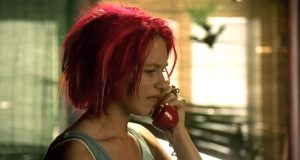


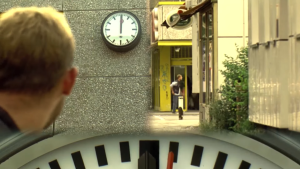

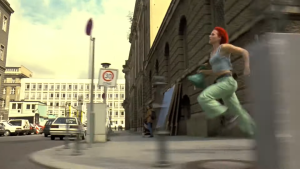
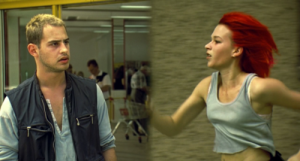
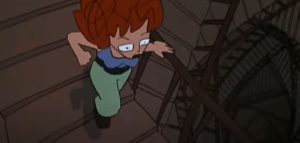
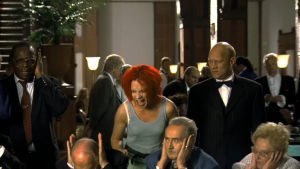

Conclusion:
“Run Lola Run” is a great showcase of what cinema can do for storytelling. The momentum of the story mixed with Lola’s determination to achieve her goal each time makes for an amazing tale. Tykwer made amazing editing choices to help tell this story. This film can be rewatched and still match the energy the first time it was viewed. An amazing film I’d recommend to anyone to check out at least once.
-Quincy Harris
Run Lola Run Continuity
Run Lola Run is not a film that feels the need to explain itself. It pieces together a story of discordant timelines and frantic trial and error, with the erratic desperation of its titular protagonist being exemplified through a feverish montage alternating between video and still image, color and B&W, animation and film. The movie is too fast to sit down and explain things to its audience — namely, why and how Lola has these abilities — and trusts the audience to piece things together on their own. It gives you just enough information to piece together what’s happening on your own without detracting from its breakneck pacing, and it is thanks to its unusual discontinuous style.
Run Lola Run keeps discontinuous imagery anchored to a strong narrative momentum by ensuring that the subject matter is always consistent, never explicitly explaining the connection between images but giving enough context clues to help them make accurate assumptions. For example, in the first running sequence, when Lola is in her room trying to figure out how she’s going to get the money to Manni, we hear her internal monologue list off a few names. Between each names, a still shot of a seemingly random person briefly flashes on screen. Given the story that’s being told, we can easily assume that these images reflect the person she is thinking of.
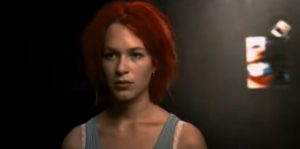
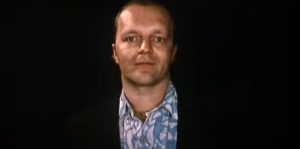
There are numerous other instances of this throughout the story, with some kind of visual cue or focal point allowing a seamless transition between continuities. When the TV cartoon transitions into main story, we are able to understand that this is just an alternatively styled presentation of Lola running by virtue of the extremely distinctive nature of her appearance (bright red hair, teal pants). This allows us to quickly understand the transition without confusion.
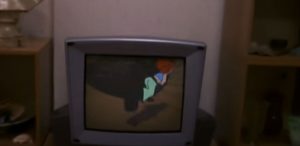

However, the most memorable way in which visual similarities are used to aid in the forward momentum of the story is how the phone acts as a focal point through which timelines shift. The first run ends with a close-up of Lola with her red hair, staring up at the red bag flying above her, spliced in with rapid cuts to the falling of the red phone. The color of the objects as well as the downward motion of the latter two creates a visual connection that allows for yet another seamless transition.
For this entire movie, she had been in a constantly restless state of movement. The one time she slows down and stops, because she has passed away, her stillness is juxtaposed against the falling motion of the bag and the phone. The moment the phone falls and stops moving, she has returned to the past and resumed movement once more.


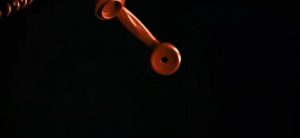
The movie does not stop to tell you that time travel is occurring. It first establishes that something unnatural is occurring with Lola speaking post-mortem, and then establishing a connection between the falling of the bag and the falling of the phone. Once those visuals have been adequately connected, the story fully pulls you back into the past and begins the next loop. It never stops to explain what has happened or why, but through visuals alone allows you to infer for yourself that she has been brought back to a sort of “save point” so she can try again.
Like its protagonist, Run Lola Run is a fast movie that is too busy to explain things to the audience, instead bringing you along for the ride and trusting that you will be smart enough to piece things together for yourself. Its experimental style perfectly complements this narrative decision, using abstract imagery and discontinuous editing to tell a story that uses the similarity and connectedness of its visual cues to help you follow along.
Week 1 Blog Post
Looping With Lola
Run Lola Run is one of the most fascinating films I’ve seen to date. From the cinematic imagery to camera positions, describing this film to someone who’s not seen it before may throw them for a loop. Describing the narrative momentum of Run Lola Run is the focus of this post however, so let’s dive into it.
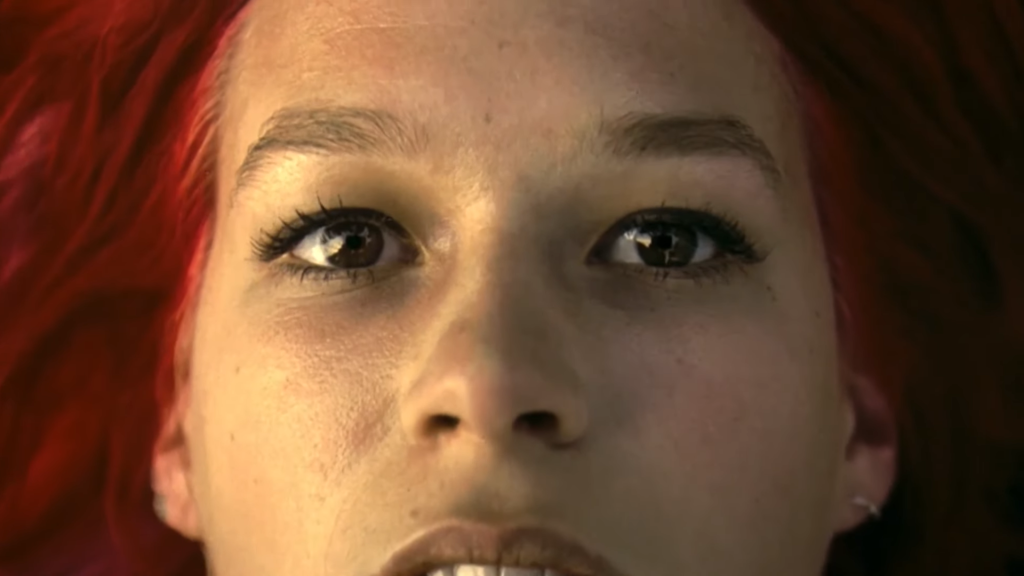
How does this film manage to keep the attention of the audience? There’s certainly a lot going on even before the time loop aspect is introduced. There are a handful of factors that retain the film’s momentum, the first being attention to detail.
The first loop introduces most of the films characters that in sequential loops have their lives changed by Lola’s actions. We see this through the pictorial montage after Lola interacts with people. As the audience, it’s interesting to us to see how the lives of the characters change with each time loop. It may entice the audience to think how the next loop will affect these characters, maintaining their interest and giving the film more room to explore this narrative.
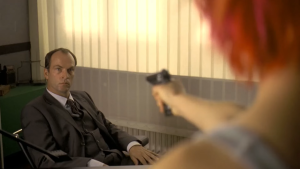
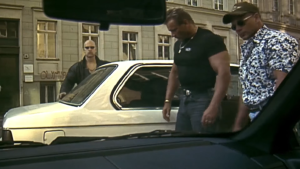
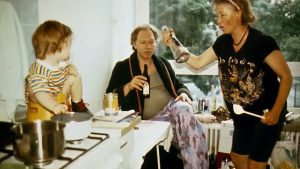
Not only do we see repeated characters through each time loop, but objects as well. Clocks are the “golden object” if you will, or the object controlling the flow of the film for the audience. The clock displays where Lola is in the narrative, especially in the following time loops. A clever plot device that helps push along the story while keeping the audience engaged with Lola’s journey.
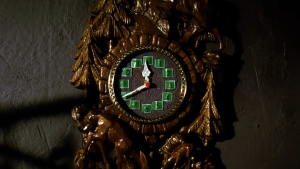

Similar to the clock, locations in the film are repeated to clearly inform the audience that a time shift is taking place. These locations also help to pinpoint Lola’s location in the narrative, such as the train crossing over the bridge that Lola runs under.
Lastly, Run Lola Run maintains the narrative flow using incredible cinematography and a tight-nit story. There are a few questions left unanswered in the film such as why Lola has super-human screams, how the time loops are happening, and other similar vein of questions. These questions don’t need answering however as I believe the story would become too convoluted for the audience if they were.


To coincide with this point, the films’ identity in the form of cinematography has no real definition since the story has no real answers. The film diverts the audience’s attention with animation, various camera shots, and overall flow to allow the audience to focus on other aspects of the film and ignore the rising questions.
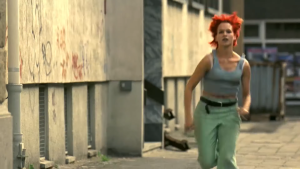
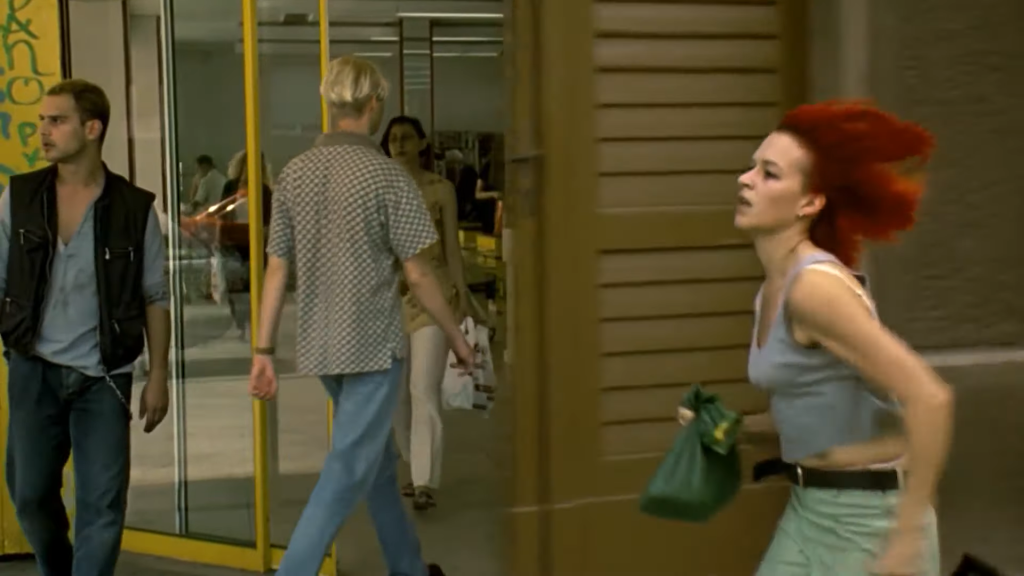
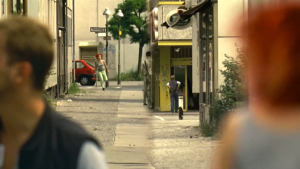
I will be recommending this film to everyone I know.
Take care,
-Caleb
introduction
Hi, my name is Sam and I am a DTC major. I took DTC 208 last semester and that gave me a lot of motivation to keep exploring the world of video production and cinematography. I look forward to future projects and learning more about the art.
Courtney Minden Introduction Post
My name is Courtney Minden and I am majoring in DTC with a minor in ARTS.
My background in video is mainly in the editing/post production aspect. I enjoy the editing process of video due to how it is the step that puts the video together by combining all of the shots and adding in sounds and effects. For me, the process of creating a video allows me to think about which shots work best and what kind of manipulation of the audio I need for the video I am trying to create.
Introduction – Jackson Lester
Hey, my name is Jackson.
I have always had a passion/interest in video and cinematography. including things such as visual effects and anything that goes into making a film. Although I am lacking in experience and technical ability, for now, I hope to dedicate and push myself to pursue this passion of mine.
Here are some great videos about the use of AI in animation, visual effects, and cinema in general.
Intro Blog Post
Hello my name is Quincy, I am a DTC Major. I have about 2 years of video editing experience in Premier Pro and iMovie. I am interested in video editing and audio work.
Introduction Post
My name is Andrew Higgins and I’m a senior in the DTC program. My interest in video comes from my love of movies and tv shows but also from my love for storytelling in general. I am into special effects and 3D work as well and I’d say that is what I’d like to pursue as a career.
Here is a cool short done by an animator on youtube:
Introduction: Week 1
Hey everyone,
I’m Caleb and this is my last year at WSU. I’m a DTC major pursuing a degree in game studies. I’ve taken 354 prior and have some experience with video editing, film making, and hyperlinked games. I’m stoked to learn more in this course. I also live in a coffee shop!
Hope everyone has a smooth semester!
-Caleb
Intro
Hi class 🙂 my name is Gunner. I love movies and filmmaking, some recent favorites have been Beau Travail and Ritual (2000). I don’t make much outside of class but am excited for the semester!
January 9th, 2024
Hi! My name is Evan and video editing is a great hobby of mine! I love stringing things together on the timeline to make a cohesive story and always get the jitters watching back what I made!
Creating is something I couldn’t live without and editing is a moderate portion of that passion!